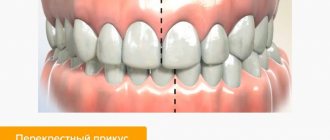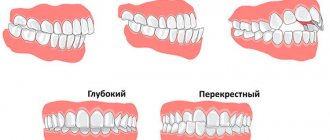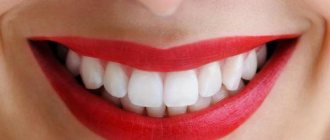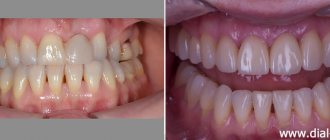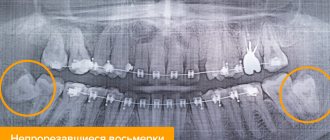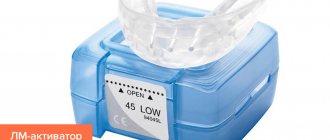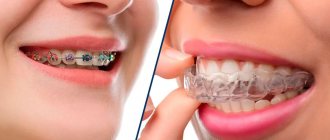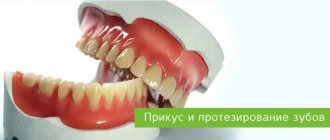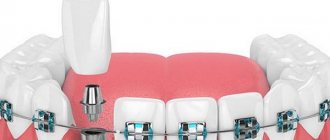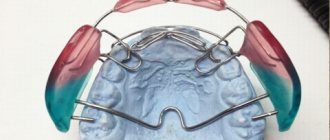Problem: parents with a 12-year-old teenager contacted the Dial-Dent orthodontic department. The boy's fangs stick out strongly, and his other teeth grow crooked. The parents wanted advice on how to correct protruding fangs, what the treatment consisted of, and how long it would last.
Solution: orthodontist O.A. Baranova performed treatment with Damon braces, aimed at normalizing the position of the fangs, straightening the teeth and correcting the bite.
Braces for fangs
If we consider all possible anomalies of the dentition, then most often it is the fangs that are crooked. According to statistics, every third orthodontic patient wants to correct the position of the “eye” teeth. Among the possible options for their dystopia:
- noticeable protrusion from the jaws (like a vampire);
- excessive or, conversely, insufficient crown length;
- closure by adjacent units located in front;
- incomplete eruption;
- turning in any direction at the wrong angle.
The “vampire smile” not only looks strange and unaesthetic, but also prevents complete chewing of food, and this negatively affects the functioning of the gastrointestinal tract. Therefore, it is imperative to solve the problem of curvature.
What are each type of teeth?
Let's take a closer look:
- The incisors are the front teeth in the middle of the jaw. They only have one root. They have an external convex and internal, slightly concave surface, as well as small tubercles at the base. They are intended primarily for tearing food into separate pieces (biting off). Due to their sufficient weakness, they are practically not suitable for chewing.
- The canines follow in a row behind the incisors, located in the corners of the jaws. They are equipped with the longest root and crown, so they are quite strong.
- Premolars are located behind the canines. Their chewing surface is much wider and has 2 tubercles for chewing. Children do not have such teeth.
- Molars are the largest size. They are designed to grind food. There are three to five chewing tubercles on the surface.
How dentists fight dystopia of “eye” teeth
Determining the curvature of the fangs is quite simple - to do this, the dentist just needs to examine the condition of the client’s oral cavity. When choosing a treatment method, the following criteria are taken into account:
- patient's age;
- features of the existing anomaly;
- degree of neglect of dental pathology.
To remove the curvature and force the canine into the correct position, the doctor may resort to the following treatment options:
- installation of braces on fangs;
- use of mouth guards;
- removal of “eights” (necessary if they are the cause of a dental anomaly);
- transformation of the first molar into a canine if the latter is missing;
- reposition (used exclusively in the most severe cases).
The sooner treatment of the curvature is started, the higher the likelihood of its complete elimination in a short time. If we are talking about providing orthodontic care to children under twelve years of age, then they are advised to wear removable plates. Typically, this method can achieve a beautiful smile in early adolescence in just six months.
Teenagers fourteen years of age and older can return the canine to its natural place with the help of braces. Adults often have to not only wear braces, but also undergo a simple surgical operation.
Treatment technique
For protruding fangs, a certain alignment technique was invented:
- Professional cleaning, which is recommended to be carried out by a hygienist. Here, plaque accumulated over many years is not only cleaned, but the health of the gums is also checked, the enamel is polished and the necessary recommendations are given.
- Sequential fixation of braces.
- Sliding the top row to obtain the necessary space.
- Moving the canines to the vacant space and stabilizing the incisors.
- Wearing orthoelastics, which provide good interdental contact. Wearing elastics is indicated 12 months after installing braces.
- Retention period.
The return of the dental fangs to the right place occurs in the fifth month of treatment. One of the arches holds the incisors in the correct position.
Why canine teeth often grow crooked or do not erupt completely?
For most children, “threes” are the very last to appear - closer to ten or twelve years. Because of this, it may turn out that there is no place for them. Then they begin to grow higher than necessary, behind or in front of their neighbors.
Another common problem with crooked eye units is the discrepancy between the size of the teeth and the width of the jaw. This phenomenon is quite common - a child may inherit a small jaw from one parent, but large, large teeth from the other.
The third cause of dental anomaly is the delayed replacement of milk units with permanent ones. There is no way to influence her. You just have to eliminate the consequences of deviation.
Classification of pathology
The following types of prognathic occlusion are distinguished:
- First type. Characterized by underdevelopment of the lower jaw. At the same time, the upper one, in its anatomical structure, develops in accordance with age.
- Second type. It is characterized by excessive development of the upper jaw along with the teeth, while the lower one is formed normally.
- Third type. In this case, changes of the first two types are combined.
- Fourth type. Involves the advancement of the front teeth of the upper jaw, which is insignificant.
Orthodontists also use the Angle classification of prognathia:
- 2 class 1 subclass. It is characterized by a narrowing of the dentition on the sides, and the front teeth of the upper jaw are fan-shaped. There is a sagittal fissure.
- 2nd class 2nd subclass. The lateral teeth are turned along their axis and deviate towards the lips, the upper front teeth tilt towards the palate. There is no sagittal fissure.
Installation of braces on fangs
Treatment with orthodontic appliances takes about one to two years. During it, the doctor takes measures to free up space for the fang - widens the jaw or removes low-functioning teeth (for example, “eights”).
If the “twos” and “fours” are too close to each other and do not allow the fang to break through, the “fours” are usually pulled out. If a crooked tooth sticks out against the background of the others, an expansion of the row and a simultaneous movement of the culprit of the problem are indicated. For this purpose, different types of braces are used - metal, ceramic, sapphire, lingual. The first ones are the most popular, as they have a low cost and at the same time guarantee good functionality.
Orthodontic appliances can be fixed exclusively on the canines or on the entire row - it all depends on the degree of curvature. This is what the average pathology correction looks like:
- Carrying out diagnostic measures (making impressions, conducting X-ray diagnostics), treating existing dental diseases.
- Professional oral hygiene designed to remove plaque and tartar.
- If it is necessary to make room in a row, a certain tooth is removed or measures are taken to widen the jaw.
- Fixation of the bracket system. On the appointed day, the doctor installs the leveling device.
- Visiting a doctor to change the degree of tension of the arc, assessing the achieved intermediate results.
- Removing braces and selecting retainers. The latter are needed to ensure that the smile remains aesthetically pleasing forever.
Removing "fours" or "sixes"
Sometimes, before installing braces, the patient needs to have the “fours” removed, that is, the first premolars - they have the smallest roots, so they are the easiest to pull out.
In addition, they bear less chewing load than, for example, molars, so their loss will not affect the patient’s health. The third candidate for removal is the fifth teeth. They are slightly larger than the “fours”, but the gaps left after their removal are practically unnoticeable when talking and smiling. Frontal teeth and canines undergo extraction much less frequently. “Sixes” are removed as a last resort, since they are quite difficult to remove, and the holes left behind them take a long time to heal. As for the seventh tooth, it is pulled out only if there is a healthy eighth tooth, in order to shift part of the load onto it. In addition, which teeth need to be extracted depends on the type of bite.
✔
In case of crossbites and distal bites, premolars, that is, either the fourth or fifth teeth, are most often removed.
✔
In case of an open bite associated with severe crowding and/or protrusion - protrusion of one of the jaws, removal of the upper and lower premolars, and at a very young age, also the canines, is indicated.
✔
As for the mesial bite, to correct it, the lower incisors are eliminated - in case of underdevelopment of the upper jaw - or “eights”.
Important!
A competent specialist, regardless of the indications, will always prefer to remove a diseased or decayed tooth rather than a healthy one.
Advantages and disadvantages of orthodontic systems
Installing braces on fangs has the following advantages:
- Even the most complex dentofacial curvatures can be cured;
- obtaining positive dynamics after several months of wearing the structure;
- Possibility of use by both children and adults;
- reliable fixation on the teeth (falling off at the most inopportune moment is excluded);
- the ability to use aesthetic devices that are practically invisible to others.
As for the disadvantages, it should be noted here:
- Difficulties in maintaining oral hygiene (cleaning out food debris from under braces is difficult and takes time);
- the need to wear the leveling structure for at least one year;
- change in the appearance of your smile for the worse during treatment;
- high cost of therapy.
Signs of pathology
Incorrect distal bite is conventionally divided into 2 types based on its characteristics. These are facial and intraoral changes. Their most severe severity is observed in adults in the complete absence of treatment.
Facial manifestations of distal occlusion:
- Violation of facial proportions - asymmetrical displacement of the lower jaw back and a small, sloping chin.
- A noticeable state of always half-open mouth.
- Change in the natural shape of the upper lip - reduced in volume, upturned or very short.
- Deformation of the lower lip.
- The teeth of the upper jaw are more developed than the lower jaw, the central upper incisors protrude strongly forward.
- Sharply defined chin fold.
Such changes in the shape of the face negatively affect the appearance, the face becomes bird-like.
Intraoral signs of a distal anomaly are as follows:
- There is no closure between the lower and upper jaw.
- The teeth of the upper frontal group are noticeably moved forward.
- The lateral teeth are located abnormally relative to each other.
In most cases, distal occlusion is formed against the background of other pathologies - diastema, trema, open or crossbite.
Is it possible to improve the bite without installing braces on the canines?
Of course, braces are the most practical, reliable and effective way to straighten teeth today. But it happens that for some reason a person does not want to wear them. This is possible due to the high cost of treatment, its long duration, and the unattractive appearance of the structures.
At the dentist's discretion, such a patient may be offered alternative methods. So, if we are talking about children, then to achieve the goal they can:
- wear custom-made mouth guards at night;
- wear soft removable plates;
- use trainers (these are devices that only affect warped units).
If an adult wants to straighten his fangs without braces, he may be offered:
- Removable mouthguards. They should be worn for about two to three years, but the dentist, as a rule, cannot give a 100% guarantee of a positive result.
- Installation of veneers. They do not remove the existing defect, but mask it perfectly. A thin, high-strength plate is glued onto the pre-ground tooth, which makes the smile much more harmonious and beautiful.
It is important to understand that only an orthodontist can decide whether to replace braces with other alignment options. If the doctor sees that the curvature is pronounced, mouth guards and plates will not help, he warns about this. In this case, there is no point in trying to correct the bite without braces.
Prosthetics for deep bite
The task of the orthopedist in this case is to eliminate damage to the mucous membranes, recreate occlusion (touching of teeth when closing), evenly distribute the chewing load and restore the height of the lower part of the face.
To do this, the occlusal surfaces of the teeth are leveled by grinding away the hard tissues. If a large number of units are missing, partial removable dentures with occlusal overlays are used. If the teeth are intact, the bite is corrected with crowns.
Refusal
The results of using braces are very good. However, sometimes patients do not want to resort to them.
This failure occurs for the following reasons:
- duration of therapy;
- high price;
- difficulty in forecasting;
- long rehabilitation.
Mouth guards can be used
It is the patient’s task to finally choose whether to use a braces system. For the same purpose there are mouth guards, trainers, and soft plates. However, for an adult they are useless.
Only mouthguards can correct the matter, and only if the fangs are only slightly protruding.
Mouth guards should be worn at night. Soft plates require much less effort to maintain than braces; on the other hand, the treatment period with them is longer than with braces. Trainers are easy to use, and they also have a targeted effect.
An adult can resort to lumineers or veneers. These devices are installed on the back side of the dentition.
- White braces
Process Features
In most cases, the fangs return to their place within a two-year course of treatment. As the position of the fang is corrected, the face will change, with and without the installation of braces. The most important thing in the treatment process is to find free space for the insertion of fangs. The solution to the problem is to remove the extra tooth.
More often, space is freed up by removing 4-6 teeth, depending on the specific structure of the dentition. If the external protrusion of the canine is slight, it is possible to do without repositioning. The tooth will be moved by the braces, widening the jaw and moving the canine in the desired direction.
Metal and aesthetic types of braces (sapphire, ceramic, etc.) are more common for treating fangs.
Care of braces and nutrition when using them
We talked about the timing of wearing braces. There is another important point that concerns many people - the necessary care of braces and proper nutrition during therapy. Keep in mind that not all foods can be eaten while wearing braces.
Here are the foods whose consumption is incompatible with the use of braces:
- solid plant foods;
- nuts;
- confectionery products such as sweets and toffees;
- tea, coffee, gas. water (when wearing ceramic/sapphire braces due to some staining due to such drinks);
- everything is very hot/cold;
- meat (if without proper care).
You will have to give up some food while wearing braces.
Important ! These tips are not a complete ban on all foods on the list. They only mean the need to reduce their use.
Hard fruits and vegetables can be softened by heat treatment, while meat can be chopped into steamed cutlets or put into casseroles. It is only important to eat gentle food.
Interesting moments that the patient described about the sensations on the aligners
The patient noted in the messenger that his tooth (fang) was moving and he was afraid to remove the aligner along with the fang! The movement of the canine as a result of removing crowding does occur, and as a result, tooth mobility can actually be felt. But since all dental movements during treatment with aligners are planned in advance, and the patient’s teeth are reliably protected in the aligners, all worries were removed.
As I told you earlier, once on a business trip in a restaurant, when he forgot the container and put the aligners next to him on a napkin, the children at the next table laughed that he had taken off his dentures
In fact, aligners can and should be stored in a special container while brushing your teeth or eating
Problems of treating crowded teeth with aligners
There were no problems at all with wearing the aligners. The only thing is that the activator came off once - this was after six months, but this was quickly eliminated and did not affect the course of treatment.
There was a case when a patient went on vacation and did not take his mouthguard retainer with him - his internal retainer came unstuck and the tooth moved back a little, “rotated” as orthodontists say. Now the problem is over.
